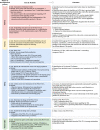The systematic and participatory development of a patient decision aid about terminal devices for people with upper limb absence: The PDA-TULA
- PMID: 36943778
- PMCID: PMC10249594
- DOI: 10.1097/PXR.0000000000000232
The systematic and participatory development of a patient decision aid about terminal devices for people with upper limb absence: The PDA-TULA
Abstract
Selecting an upper limb prosthesis seems to be a challenge considering the high rejection rates. A patient decision aid (PDA) could support the decision-making process by providing information about available options and clarifying the patients' values related to those options. This study aims to describe the developmental process of a PDA about terminal devices (TDs) for people with upper limb absence: PDA-TULA. The developmental process was based on The International Patient Decision Aid Standards. We aimed at adults with major unilateral upper limb absence. A steering group including patients, clinicians, researchers, software and implementation experts was composed. The content and design of the PDA were based on a qualitative literature meta-synthesis, focus groups with patients and clinicians, surveys among patients and prosthetists, a nationwide digital meeting with clinicians and prosthetists, and information from manufacturers. Information on features of TDs was systematically collected, ordered, and refined. Subsequently, drafts of the PDA-TULA were made, improved, integrated into the software, and alpha tested. The digital PDA-TULA consists of three parts: (1) information about TDs; (2) consideration of personal values regarding the TDs; (3) comparison of TD profiles with a personal profile based on indicated preferences. A summarizing overview is offered to patients and clinicians. To conclude, a digital PDA, which was integrated into the national working process of clinicians, was developed in a systematic co-creation process. The PDA enables patients and their significant others to consider and formulate their preferences about TDs during the prosthesis selection process.
Copyright © 2023 The Authors. Published by Wolters Kluwer incorporated on behalf of The International Society for Prosthetics and Orthotics.
Figures



References
-
- Østlie K, Lesjø IM, Franklin RJ, et al. . Prosthesis rejection in acquired major upper-limb amputees: A population-based survey. Disabil Rehabil Assist Technol 2012; 7: 294–303. - PubMed
-
- Salminger S, Stino H, Pichler LH, et al. . Current rates of prosthetic usage in upper-limb amputees—Have innovations had an impact on device acceptance? Disabil Rehabil 2022; 44: 3708–3713. - PubMed
-
- Biddiss EA and Chau TT. Multivariate prediction of upper limb prosthesis acceptance or rejection. Disabil Rehabil Assist Technol 2008; 3: 181–192. - PubMed
-
- Johnston P, Currie LM, Drynan D, et al. . Getting it “right”: How collaborative relationships between people with disabilities and professionals can lead to the acquisition of needed assistive technology. Disabil Rehabil Assist Technol 2014; 9: 421–431. - PubMed
MeSH terms
LinkOut - more resources
Full Text Sources
Medical

